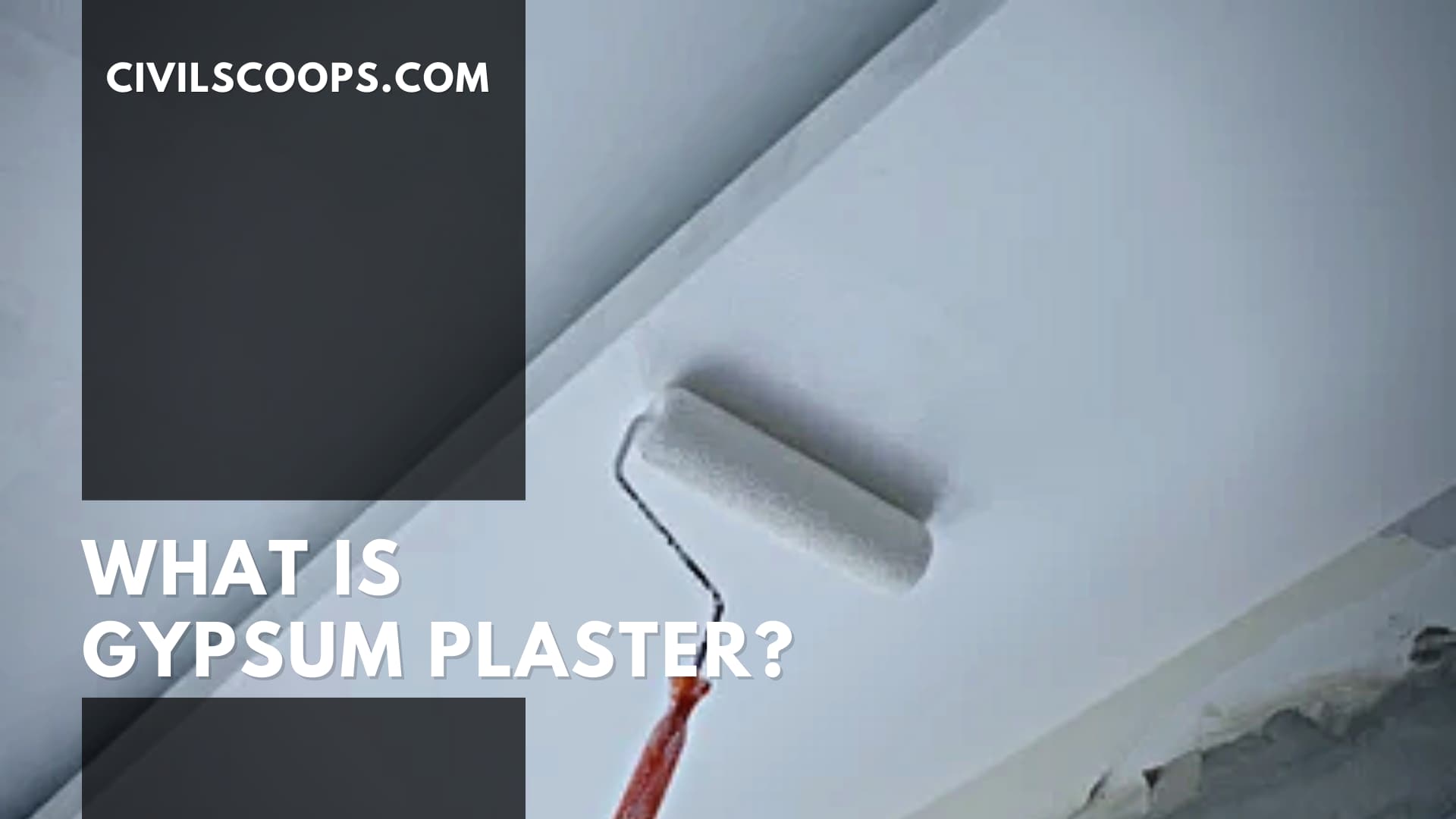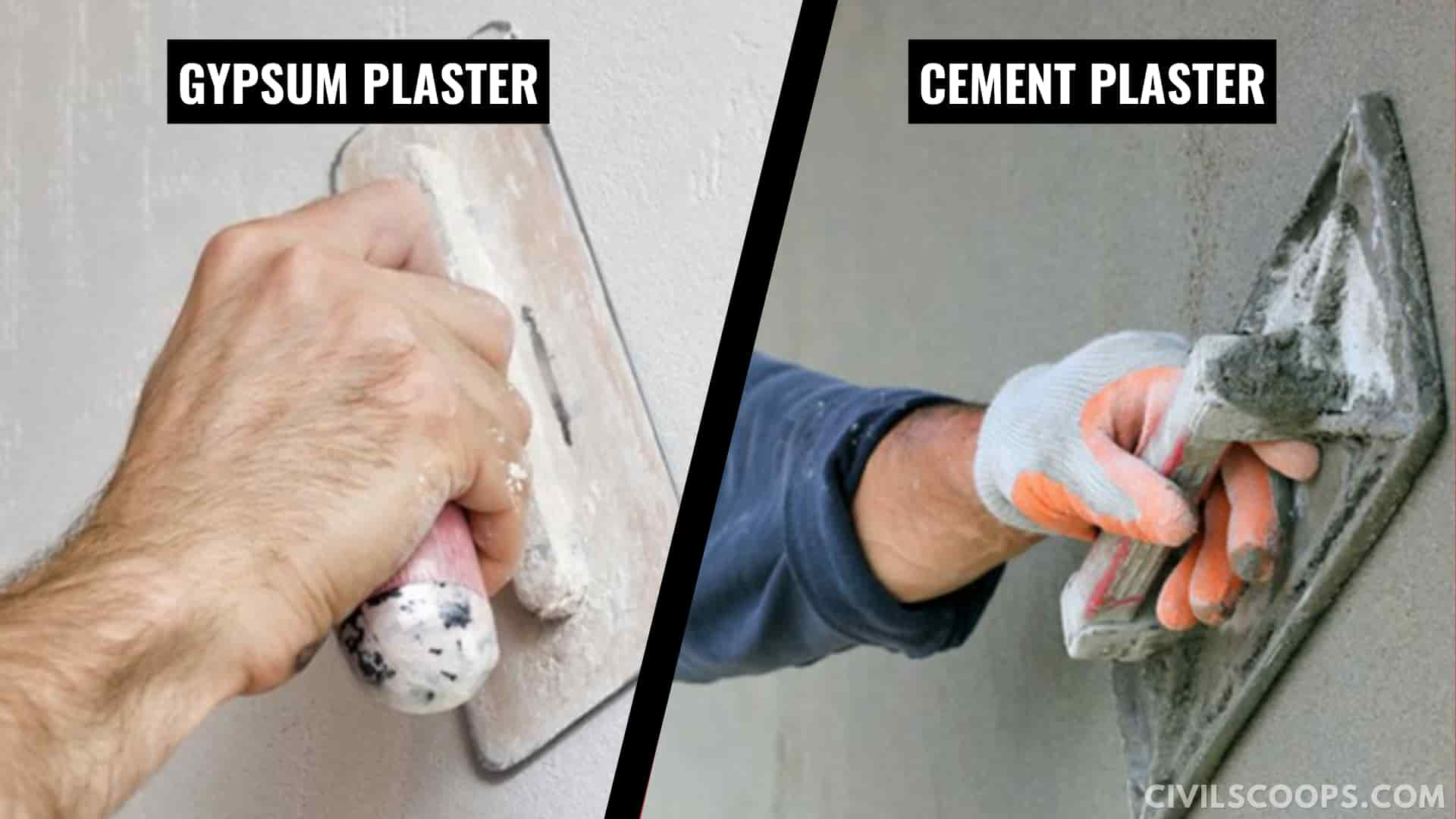21 Difference Between Gypsum Plaster and Cement Plaster | What Is Gypsum Plaster | What Is Cement Plaster

Table of Contents
What Is Gypsum Plaster?

Gypsum plaster is made by heating gypsum at low temperatures to drive off water, to produce plaster of Paris a chalky, fast-setting material commonly used for molds and for casts to repair broken bones.
It can be mixed with time to form a fast-drying interior finish plaster known as gauging plaster, according to Bob Campbell, a 17-year plasterer who began work in Scotland.
Lime and gauging plaster, he tells us, aren’t very popular anymore. If gypsum is heated at higher temperatures, the resulting product is anhydrous calcium sulfate. This substance is most commonly used to manufacture drywall and drywall compound. It is also used as an interior plaster.
What Is Cement Plaster?
The cement plaster consists of one part of cement to four parts of clean, coarse, and angular river sand by volume the materials are thoroughly mixed in a dry condition before water is added to them.
The mixing of materials is done, or a watertight platform and plaster of one cement bag only are prepared at a time, and this quantity of plaster is consumed within 30 minutes after adding water.
Gypsum Plaster Vs Cement Plaster

[su_table responsive=”yes”]
| Sr.No. | Gypsum Plaster | Cement Plaster |
| 1 | Whereas gypsum plaster can only be used in interior rooms it cannot be used in wet areas like toilet baths kitchen wash area balconies etc. | Cement plaster can be used for plastering both the external walls and the internal walls and ceilings of the building. |
| 2 | Gypsum plaster does not shrink as it undergoes very little expansion and contraction. So there are fewer Shrinkage cracks in gypsum plaster as compared to traditional cement plaster. | Cement plaster has the tendency to shrink, which results in hairline cracks on the plastered surface. |
| 3 | Gypsum plaster is highly resistant to mold and mildew. | Cement plaster is prone to attacks by mold or mildew. |
| 4 | Gypsum plaster doesn’t need any curing saving water and time during construction. | The cement-plastered surface needs curing with water for at least 7 days. Do note that improperly cured walls develop cracks. |
| 5 | Gypsum plaster isn’t resistant to moisture. | Cement plaster is resistant to moisture. |
| 6 | Gypsum plaster, gypsum is used as a binding material instead of cement. Gypsum plaster is ready to use and does not need sand. | Cement plaster is a homogeneous mixture of Portland cement and sand with water. Sand and cement are mixed at the site in different ratios. |
| 7 | Gypsum plaster is generally 11 mm thick for walls and 8 mm thick for ceiling and finish coat plaster is 2 mm thick. | The thickness of the cement plaster should not be less than 10 mm. For example, for brick walls thickness of plaster is 12 mm to 20 mm. For the interior of the RCC ceiling/ roof, the thickness of the plaster is generally 10 to 12 mm. |
| 8 | Gypsum plaster has low thermal conductivity and good thermal properties and ensures energy and power saving. | It has less same thermal conductivity as Gypsum plaster. |
| 9 | Gypsum plaster can prevent shrinkage because it has high tensile and flexural strength. | Cement plaster can develop shrinkage because it has Low tensile hand fractural and strength. |
| 10 | Gypsum is non-combustible and contains a high content of crystal water. In the event of a fire, it acts as a barrier and will protect. | Cement plaster up to 200 to 300 C acts as refractory material and resists fire but later it becomes brittle and breaks and falls and loses bond with the wall. |
| 11 | Gypsum as a binder is used in the manufacture of acoustic tiles and plasters, a contributory factor to the absorption of airborne sounds. | Cement plaster has more or less the same acoustics properties. |
| 12 | Due to the nature and structure of gypsum, it exhibits excellent bonding properties and hence is applied in a single coat on RCC ceilings, internal bare-brick walls, AAC blocks, and concrete columns. | Cement plaster cannot be applied on a smooth surface. |
| 13 | The setting time of gypsum plaster can be controlled. The time between two successive coats is very small. | The minimum 24-hour interval between coats of interior Portland cement plaster. After a 48-hour period finish coat plaster may be applied to the interior cement base coat. |
| 14 | The percentage of wastage is nominal during application. | The percentage of wastage is higher during application. |
| 15 | The application of gypsum plaster is a time-saving process, thus decreasing the project cost. Gypsum plaster is costlier than cement plaster for the same thickness. | The application of cement plaster is a time-consuming process hence increasing the project cost. However, the per square foot cost of cement plaster is less than gypsum plaster due to the higher cost of gypsum. |
| 16 | After sand cement plaster, POP punning is required for a better and level surface finish. The space looks small and unattractive as it is dark grey in color. | Gypsum plaster provides a smooth interior finish for ceilings, and walls and is an ideal background for good quality paints and wallpaper finishes. The room space looks large and beautiful as gypsum plaster is pure white in color. |
| 17 | Gypsum plaster keeping is not required we can directly apply the paint. | In the case of cement plaster, we need pop punning on the plastered surface to receive paint. |
| 18 | Whereas gypsum plaster is a green building product. | Whereas gypsum plaster is a green building product. |
| 19 | Gypsum plaster is a time-saving process thus decreasing the project cost. | Cement plaster is a time-consuming process, hence increasing the project cost. |
| 20 | The density of gypsum plaster is less as compared to cement plaster gypsum plaster is light in weight. | The density of cement plaster is higher than gypsum plaster, hence the load on the building increases. |
| 21 | Gypsum plaster is the perfect rust preventive agent and also inhibits corrosion of electric metal, fitting. Pipes etc. | Cement plaster is not a rust inhibitor. |
[/su_table]
[su_box title=”FAQ” style=”default” box_color=”#333333″ title_color=”#FFFFFF” radius=”3″ class=”” id=””]
Gypsum Plaster
Gypsum plaster is, white cementing material made by partial or complete dehydration of the mineral gypsum, commonly with special retarders or hardeners added. Applied in a plastic state (with water), it sets and hardens by chemical recombination of the gypsum with water.
Gypsum Plastering
Gypsum is a soft sulfate mineral composed of Calcium sulfate dihydrate (CaSO4:2H20). It is widely used as a fertilizer, in mold, in sculptures, and as plaster material. Gypsum although a much older material than cement & sand plaster has rarely been used extensively in the construction industry.
Gypsum in Cement
Gypsum (composed of crystallized calcium sulfate (CaSO4) is added to Portland cement to regulate the extreme setting reaction which occurs in the presence of water. The gypsum content of cement is expressed in terms of its sulfate (SO3) content.
What is Gypsum plaster?
Gypsum plaster is, white cementing material made by partial or complete dehydration of the mineral gypsum, commonly with special retarders or hardeners added. Applied in a plastic state (with water), it sets and hardens by chemical recombination of the gypsum with water.
Gypsum Plaster Vs Cement Plaster
Cement plaster can be used on exterior and interior surfaces. Whereas gypsum plaster can only be used on the ceiling and interior walls it cannot be used in wet areas like toilet baths kitchen wash areas balconies etc. Whereas gypsum plaster gives a very smooth finish which makes it compatible with paints.
Gypsum Plaster Vs Cement Plaster Cost
Gypsum plaster is costlier than cement plaster for the same thickness. The application of cement plaster is a time-consuming process hence increases the project cost. However, per square feet cost of cement plaster is less than gypsum plaster due to the higher cost of gypsum.
Gypsum Wall Plaster
In gypsum plaster, the readymade POP powder is mixed with water and applied directly to the wall. Gypsum Plaster can be applied directly on any brick, solid or hollow blocks, AAC blocks, and plasterboards. Gypsum plaster has good insulation properties, fire-resistant and impact are resistant.
Difference Betwee Gypsum Plaster and Cement Plaster
Gypsum plaster can be applied on smooth as well as a rough surface. Cement plaster gives a rough surface. Whereas gypsum plaster gives a very smooth finish which makes it compatible with paints. During the application of cement, plaster wastages are high.
Gypsum Plaster for Exterior Walls
Gypsum plaster cannot be used for outside walls since they retain dampness. Also gypsum plastering cannot be done in areas which are continuously damp such as bathrooms etc. Gypsum plaster is costlier than traditional cement motar plaster (cement and sand) for same thickness of plaster.
Gypsum Plaster Vs Neeru Plaster
Gypsum plaster can be applied on smooth as well as a rough surface. Neeru plaster gives a rough surface. Whereas gypsum plaster gives a very smooth finish which makes it compatible with paints. Rendering or application of Lime paste/ Putty to fill cracks and uneven surfaces to obtain a smooth and level finish is called neeru finish.
Gypsum Plaster Cost Per Square Foot
[su_table responsive=”yes”]
| Item details | Qty | Low |
| Gypsum Plastering Labor, Basic
Basic labor to apply gypsum plaster with favorable site conditions. Clean substrate. Mix veneer plaster. Trowel plaster onto substrate. Float/tool for uniform thickness and consistent finish. One component system. Includes planning, equipment and material acquisition, area preparation and protection, setup and cleanup. |
6.5 h | $ 518 |
| Gypsum Plastering Job Supplies
Cost of related materials and supplies typically required to apply gypsum plaster including fasteners, seam tape, outside corner beads and topping compound. |
129 SF | $ 26 |
| Totals – Cost To Apply Gypsum Plaster | 120 SF | $ 544 |
| Average Cost per Square Foot | $ 4.53 |
[/su_table]
Cost Comparison Between Gypsum Plaster and Cement Plaster
Gypsum plaster is costlier than cement plaster for the same thickness. The application of cement plaster is a time-consuming process hence increasing the project cost. However, per square feet cost of cement plaster is less than gypsum plaster due to the higher cost of gypsum.
[/su_box]
[su_note note_color=”#F2F2F2 ” text_color=”#333333″ radius=”3″ class=”” id=””]
Like this post? Share it with your friends!
Suggested Read –
- Procedure for RCC Concrete
- Testing for Silt Content in Sand
- What Is Bleeding In Concrete | What Is Segregation In Concrete
- What Is Sand Blasting | Concrete Sand-blasting Equipment | Key Benefits of Sand Blasting
- What Is Pedestal | Functions of Pedestal | Methods of Construction: Pedestals | Advantages and Disadvantages of Pedestal
[/su_note]
Originally posted 2022-07-09 06:48:58.
